| How to Collect Meteorites |
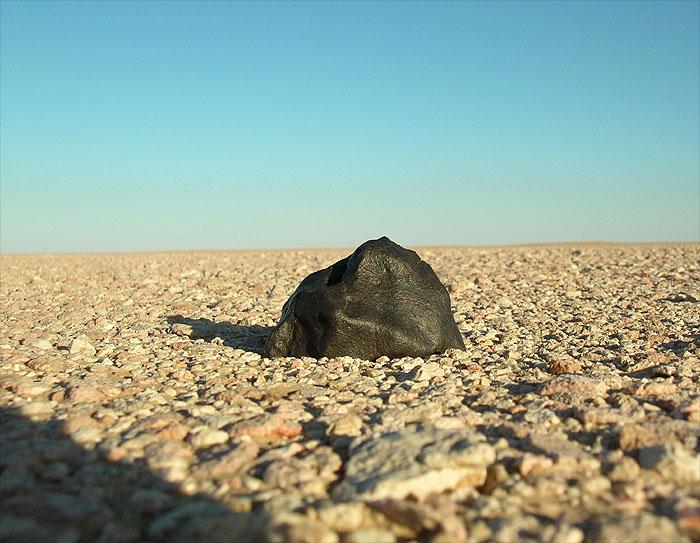 |
| Almahata Sitta Meteorite |
|
|
If you are reading this page you probably have figured out that it is indeed possible to own meteorites and to build your own great collection! Hopefully we can give you some great tips for making your meteorite collecting experience even better…
Not so long ago meteorite collections were something you saw in a museum – a private collector was someone who was wealthy and who had a passion for space. Not any more! Today’s collectors come from all walks of life and all parts of the world. The Internet has brought these diverse and geographically separated collectors of space rocks together into an amazing and significant virtual collecting community.
Over the last twenty years many huge meteorite finds have occurred throughout the deserts of northwest Africa (NWA) - these recent discoveries have been responsible for bringing large amounts of fantastic new material to the collecting marketplace. An increasing awareness of meteorites by the general public over the same time period has also insured that more potential finds are being investigated and more material is reaching scientists and collectors. Once only the domain of scientists, meteorite hunting has become a growing hobby with great utilization of new technologies such as advanced metal detectors, handheld GPS units, and Google Earth software. All of these improvements have helped to make literally tons of new meteorite material available – at much lower prices.
OK I want to be a collector - but how do I know what I am buying really is a meteorite?
This is the first question that everyone starting out in this hobby always asks...
To be successful collector - you really just have to follow a few basic rules in order to feel confident that you are building a meteorite collection which is truly authentic. These important collecting basics are covered in each of the sections below.
Is it actually legal to own meteorites?
Yes it is! Private meteorite collectors have built some of the world's greatest collections - and many of these these past historic private collections have become the foundations of the most famous museum collections that we see today. This cycle still continues - take a look at this page to see the most famous museum collections from around the world - as well as the current private collections which have the potential to become the great museum displays in the future:
http://www.meteoritecollector.org/museums.html
Maybe you will build one of the worlds great collections - most of these amazing collections all started out as a single collector simply buying their first meteorite.
Most of the legal issues around meteorites are focused on the import and export of the material over national borders. Each county has its own specific set of rules and regulations regarding any approvals or customs forms required for international shipping. Buying meteorites from reputable dealers will help you to stay in compliance with export rules. Canada and Australia are examples of countries which may require special export permits.
Another legal area of concern is actual meteorite ownership - each country has different laws and rules about who the original owner of a meteorite is depending on where is has fallen or where it was discovered. This ownership can vary between private and public lands - and it certainly varies between countries. In the US a meteorite belongs to the land owner where it was recovered - in other countries the meteorite may belong to the government first and then it may be later released or sold to a third party.
Meteorite hunters who search on private or public lands usually have agreements about have the proceeds from any meteorite finds will be distributed between the hunter and the land owner. The key issue for the collector is making sure that when you are buying a meteorite - especially when purchasing a new find or discovery - that you are getting it from the actual owner of the meteorite and not from someone who might have poached it from either public or private land without permission. Only working with reputable dealers and hunters will avoid these issues.
|
| Rule One: Understand meteorite sources |
 |
| Not a meteorite - it is an airplane contrail! Jon Burnett in South Wales |
|
|
The first and most obvious source is if someone actually sees a meteorite fall – this is generally referred to as a witnessed fall. Shortly after the falling meteor is reported – hunters and local residents will start the meteorite search. This is the best time to find and identify the meteorite rocks because the original large stone usually explodes before impact – sending a shower of smaller blackened and melted rocks to the ground scattered over many miles. This fall area is called a strewnfield and it is the source of many specimens for the private collector. Unlike in the movies - most meteorites do not end up in as a single rock resting in a smoking hole in the ground.
The second source of meteorites is unusual rocks which are found in barren and rock-free places. Black stones with a smooth fusion crust found on the ice in Antarctica, black or dark brown rocks found in the empty deserts of the Sahara, and large stones which unexpectedly appear in farmer’s fields all have the potential to be scientifically confirmed as meteorites. Once this happens – they are considered classified – and they are published for worldwide reference in the MET-BULL database:
http://tin.er.usgs.gov/meteor/metbullcheck.php
This is the single best resource on the internet for a serious meteorite collector!
The third source of meteorites for collectors is specimens from existing collections and museums. Many of these meteorite specimens have been collected and cataloged over the last two hundred years – and a certain percentage of this material has found its way into the private collector market as smaller individuals, slices, and fragments. Many of the early specimens are considered historical and they are quite collectable and valuable.
|
| Rule Two: Learn the basic meteorite types |
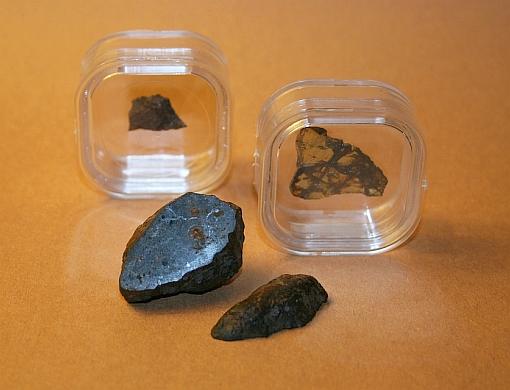 |
| Meteorites |
|
|
Buying a meteorite specimen always involves some risk – after all you are paying a significant amount of money for something which might just be an ordinary rock!
The good news is that many meteorites generally do not look or feel like Earth rocks – especially if they are sliced open. Almost all meteorites will attract a magnet – only a very tiny percentage of known meteorites are non-magnetic. This is the first basic check for confirming a meteorite. The second obvious characteristic is that many meteorites are much heavier than ordinary Earth rocks – just holding the rock and feeling the greater weight can be a sign that it is real.
Since the majority of meteorites contain a unique percentage of iron and nickel - looking inside the stone can give an indication that it is a meteorite. Most real specimens contain some visible metal flecks if it is potentially a stony meteorite, or it can be composed of solid metal if it might be an iron meteorite, or it may display an amazing combination of rock, metal, and gem-like olivine if it could be a stony-iron meteorite called a pallasite. See our examples in the photos below.
Another good meteorite indicator is that a significant percentage of stony meteorites - called chondrites - contain small little visible circles imbedded in the matrix which are referred to as chondrules. These colorful little circles are unique to meteorites and they are one more great indicator that a rock has a good possibility of being from space. Another related class of stony meteorites is called achondrites and these stones can have a wide variation in their interior matrix appearance. These sliced specimens are usually very beautiful and collectable - but they also require careful scientific examination to confirm their origin as a meteorite.
|
 |
| Stony - Metal Flecks |
|
|
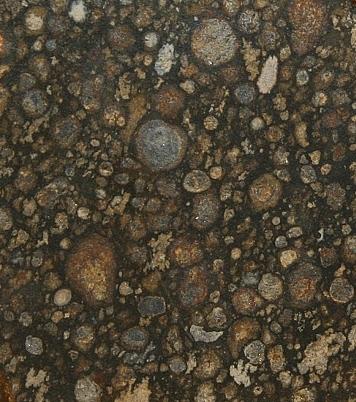 |
| Stony - Chondrules |
|
|
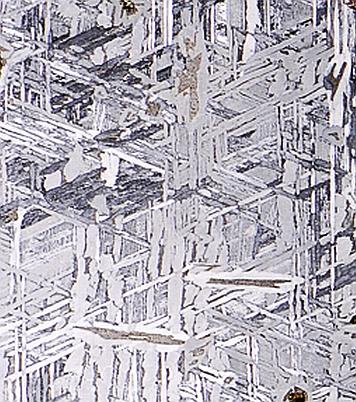 |
| Iron - widmanstatten pattern |
|
|
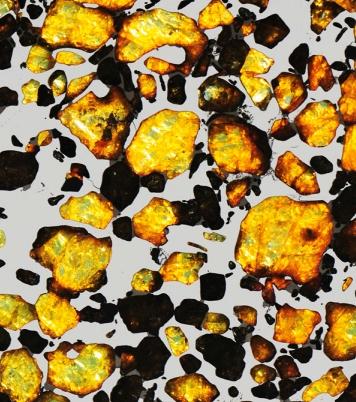 |
| Stony-Iron - Pallasite |
|
|
Iron meteorite slices that have been etched also display another unique meteorite indicating characteristic – they show a beautiful widmanstatten pattern. This is usually a dead giveaway that an iron meteorite is real. Further advanced testing can be done to prove a meteorite is real (iron-nickel percentage tests, etc.) - but a careful collector should probably always keep these minimum basic indicators in mind when making a purchase.
To get even better at recognizing a meteorite it is also helpful to see some examples of ordinary earth rocks that have been already misidentified as a potential meteorite (these are sometimes called meteorwrongs). Washington University in St. Louis has created a great website loaded with images of ordinary earth rocks that have submitted to them as potential meteorites:
http://meteorites.wustl.edu/meteorwrongs/meteorwrongs.htm
If you think you have found a meteorite you might want to compare it to the photos on that website before reporting it to anyone. Only one out of every hundred or so meteorites reported by the general public actually end up being the real thing!
|
| Rule Three: Only buy from trusted sources |
 |
| Would you buy from him? We would! He is Bob Haag, one of the world's most respected and accomplished collectors! |
|
|
Finding reputable dealers is critical to having a successful experience when purchasing meteorites. Here is the bad news -- if you are just starting out and thinking about using eBay to buy meteorites – eBay is not a trusted source. However, the good news is that eBay does have the largest number of offerings from reputable dealers. Unfortunately, mixed in with the good stuff is a lot of fake and misrepresented material. The fake stuff is there for only one reason – to rip-off a beginning collector. So always keep this in mind when you are buying on eBay – because every beginning to advanced collector still buys a big percentage of their meteorites on eBay despite all the fraud. The key is to only make puchases from the reputable sellers.
If you are just beginning this hobby – there are two places you can go in order to identify reputable dealers for buying meteorites. The first place is our dealer list at MeteoriteCollector.org:
http://www.meteoritecollector.org/dealers.html
These are dealers we know and trust – and in most cases we have already made several meteorite purchases in the past and confirmed them as authentic from the listed dealer. We list both eBay stores and dealer websites - both of these are excellent sources for puchasing collection pieces. In some cases private collectors will sell excess material as well – and we have listed those people we have also made authentic purchases from on the same page. These stores and websites are your best bet for starting out. Some of the dealers listed specialize in helping begining collectors - others are focused on highly advanced collectors. It does not take too long to determine which type of collector a seller is targeting after you spend some time seeing the bid prices and listed offerings.
Most experienced collectors recommend going slow as you enter the market. Take some time to watch the auctions - and go ahead and bid on a few of the lower priced items from the reputable dealers - nothing gets a collector more excited than opening the mailbox after winning an auction or placing an order. After a while you will start to gain confidence in knowing the value of what you are seeing - the meteorite market is a bit challenging to learn - but it is really about the same as any other collectables market. The learning curve is worth it if you start to seriously collect meteorites - after all - what can be cooler than owning actual space rocks?
The second place you can go to find trusted sources is the membership list at the International Meteorite Collectors Association – its members are admitted to the organization based on their commitment and reputation for authenticity:
http://imca.cc/index.php?option=com_cb_search&task=usersList&Itemid=11
These are the collectors and dealers around the world who are authorized to use the IMCA logo in their eBay listings are on their websites – each logo contains the member’s unique IMCA member number. This is about as good as it gets in the meteorite world for building trust in a meteorite purchase. Look for this logo - and take the time to confirm it at the IMCA website.
|
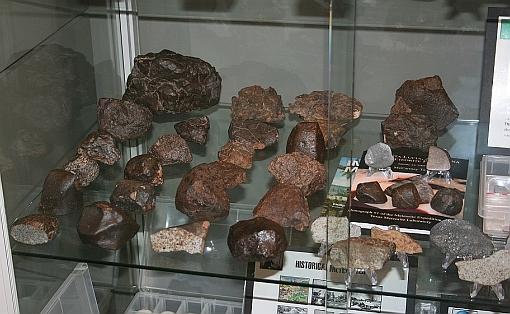 |
| Meteorite Display |
|
|
|
As collectors we all have different interests and passions. Our unique collections are a reflection of these pursuits. Deciding what kinds of meteorites to collect can be a bit overwhelming – Stony, stony-iron, or iron? A little of each? Large specimens, macros. or micros? Certain countries, states, or regions? After all – almost forty thousand meteorites are listed in the MET-BULL online database! That gives a huge number of collecting approaches from which to choose.
If you know you want to start collecting - but you have no idea where to begin - you can start with our "challenge collection" - it is a list of sixty meteorites selected by meteorite experts as a good starting point for learning about the hobby. You can find the "2012 Space Rocks Sixty challenge collection" recommended list on this page to use as a starting point for your own collecting pursuit:
Some other great meteorite collecting suggestions are listed by well known collector and hunter Geoffrey Notkin on this webpage:
http://geology.com/meteorites/meteorite-collecting.shtml
Here are some of his suggestions for picking a specific focus area:
Type Collection – This would be based on the scientific classifications of the specimens
Historic Specimens – These are meteorites which are very old or have great stories
Witnessed Falls – As mentioned above, meteorites which were seen falling
Aesthetic Shapes – A passion of Geoff’s – great looking specimens!
Individuals and Fragments – Basically collecting meteorites which are still whole and intact
Slices and End-cuts – Collecting specimens which allow the viewing of the interior
Another approach is to try collect all of the meteorite specimens obtainable for a specific country or state. Many people focus on places like Australia, Europe, Texas, Northwest Africa (called NWA), or China - the possibilities are endless.
Other collectors focus on the planetary meteorites which are either Lunar or Martian. These are some of the most difficult, rare, and expensive specimens for anyone to attempt to collect!
Even more great collecting tips can be found in this article by Michael Gilmer which is posted at Cloudy Nights:
http://www.cloudynights.com/item.php?item_id=1929
He also suggests one of the same approaches as Geoffrey Notkin which is to attempt to build a Type Collection. If you think you might want to take up this enormous challenge - you can find the complete list of meteorite classifications on this webpage to aid you as a reference:
http://www.meteoritecollector.org/classifications.html
Good luck with which ever approach you select - almost every collector ends up collecting a little bit of everything anyway – so don’t worry too much about which direction you may choose to pursue. You can see how we made our own personal choices for our collection acquisitions and target groupings by visiting the FCOM Collection photo albums here:
http://www.meteoritecollector.org/gallery/main.php
|
| Storing and Protecting a Collection |
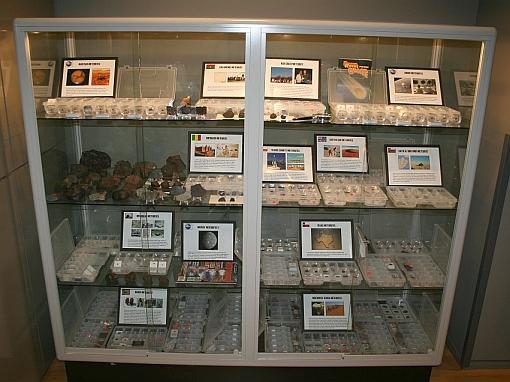 |
| Meteorite Display |
|
|
If you get seriously bitten by the meteorite collecting bug – eventually you will have to start to worry about these things:
Storage and Display – There are as many ways of doing this as there are collector’s imaginations. Shop around for containers and printer labels which fit your space needs. If you collect big pieces and slices you may want a bookcase or shelves for display.
Labeling – This is vital to maintaining the value of a specimen! A specimen should be kept in a labeled container, compartment, or bag in order to maintain the providence of the piece. Most specimens come with an ID card to link the piece to the previous owner or dealer. Some specimens may come with more than one card if they are historic. Keep all of these cards! A future buyer or institution will want to receive these to determine authenticity. You should always try to get these from dealers and collectors when you make your own purchases.
Rusting – If you collect iron meteorites (especially slices) you will have to worry about rust. Don’t ignore this issue – if you do you may find yourself one day with bags full of weathered dirt instead of the original shiny slices! Fortunately, the internet is loaded with advice for preserving your meteorites. One place to look is here:
http://www.cloudynights.com/ubbthreads/showflat.php/Cat/0/Number/3149810
We also use many of these products listed at this site to protect our iron and pallasite specimens:
http://www.paleobond.com/ct_CGmeteoriteproducts.htm
We also use dessicant beads inside of some of our storage boxes to help to reduce moisture.
Security – A large collection is a valuable collection. Think about where you store it, how secure the space is, and whether you may need insurance. Most serious collectors catalog and photograph their collections in case something is ever stolen.
Following some of these best practices and tips should make your own experience with meteorite collecting even better! Once your collection gets big enough - you may want to meet other collectors and share your experiences. See our links on the left side for forums and lists you can use right away to meet other people with the same meteorite collecting passion. Visiting these sites will help to enrich your experience and give you a place to show off the collection you are building. Meteorite collectors are great about sharing their knowledge - join the forums and lists to take advantage of this wealth of experience!
|
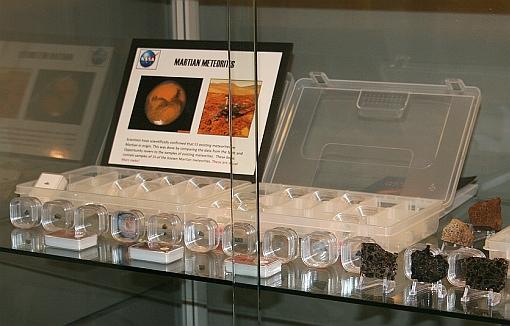 |
| Meteorite Display |
|
|
|